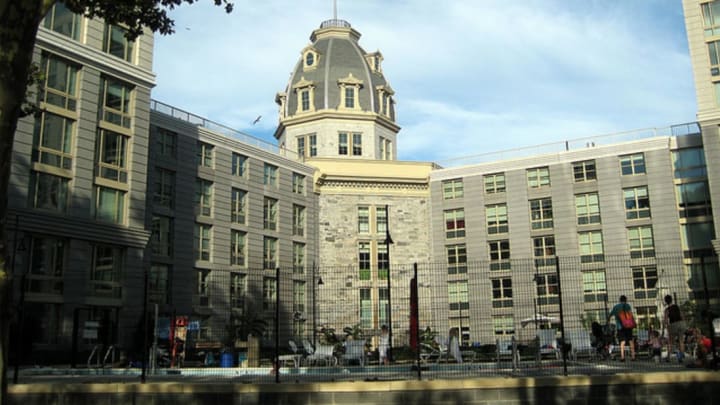Psychiatric hospitals often hold a dark place in the popular imagination. Whether it’s Gotham’s Arkham Asylum, Boston’s Shutter Island, or Briarcliff Manor in American Horror Story, such institutions frequently conjure vivid images of mental and physical suffering.
But as our understanding of mental health changes, so does our treatment, hopefully toward methods that are more humane. In the 1970s and 1980s, deinstitutionalization saw many treatment centers (notorious and otherwise) close their doors. For some psychiatric hospitals, that meant demolition—while for others, it meant a sometimes-surprising second life. Here are some new uses for old hospitals:
1. A LUXURY HOTEL
pilot_micha via Flickr // CC BY-NC 2.0
The Welcome Hotel Residenzschloss in Bamberg, Germany, sits right on the River Regnitz near the center of town. The Catholic Church built it as a hospital in 1787, and in 1990 it reopened as a luxury hotel with 184 rooms and suites, two restaurants, and a spa. Reviewers on TripAdvisor praise its Baroque elegance and romance, although one also calls it “quiet as a grave.”
2. A MUSEUM AND CONFERENCE CENTER
Jean-Pierre Dalbéra via Flickr // CC BY 2.0
The island of San Servolo lies in the lagoon of Venice, less than 10 minutes from the famous St. Mark’s Square. Although it was originally conceived as an asylum for noblemen, between 1725 and 1978 more than 200,000 people of all genders and classes came to live at a psychiatric hospital established there. Today, San Servolo is home to the Museum of Madness and a conference center capable of holding up to 400 attendees in a room. If you don’t want to take the water taxi to the mainland, there’s also a 300-bed hotel on the island.
3. THE DEPARTMENT OF HOMELAND SECURITY HEADQUARTERS
Tomf688 via Wikimedia // CC BY-SA 2.5
Washington, D.C.’s St. Elizabeths Hospital has been home to several would-be presidential assassins, the poet Ezra Pound, and a serial killer nicknamed the “Shotgun Stalker,” but its next residents are charged with maintaining national security. The Department of Homeland Security announced in 2007 that it would consolidate its headquarters at the building, but preservation concerns, budget issues and the small number of remaining patients at the facility (including longtime resident and President Reagan shooter John Hinckley) have created government boondoggles impressive even for the capital.
4. ARTS AND CULTURAL CENTERS
Fergus Falls State Hospital by Mr. Moment via Wikimedia // CC BY 2.0
Many mental health institutions were designed to be soothing and attractive, features that would later make them perfect arts and cultural centers. Fergus Falls, Minnesota, has created a resident artist program at its Fergus Falls State Hospital. Traverse City, Michigan, has repurposed the Northern Michigan Asylum as a mixed-use development and cultural hub as well as a park outside of town. The Ridges, a famous (and infamous) former institution in Athens, Ohio, is now home to several university offices, as well as an art museum and arts center. Australia’s Fremantle Arts Centre began as the Fremantle Lunatic Asylum and Invalid Depot, later the Asylum for the Criminally Insane.
5. TECHNOLOGY COMPANY OFFICES
Wayne Hsieh via Flickr // CC BY-NC-SA 2.0
The Agnews Insane Asylum opened in Santa Clara, California, in 1889, and within a few years it had grown large enough to necessitate its own train station nearby. It became infamous after the San Francisco earthquake of 1906, when more than 100 patients died after buildings collapsed. The hospital shifted focus from mental health to developmental disabilities by the 1970s, and in 1997, the now-defunct Sun Microsystems announced it would redevelop the site for its corporate and R&D headquarters. The site is now owned by Oracle.
6. HOUSING
Wellcome Trustvia Wikimedia // CC BY 4.0
While some may be dubious about the prospect of living in a former mental hospital, developers see the sites as prime real estate. In England, the town of Ipswich approved plans last year to convert the former St. Clement’s Hospital into residences. Large portions of the hospital will be demolished to make room for modern apartments and amenities, but the principal building will be used to create 48 new housing units.
For anyone concerned about potential psychic residue, there are “energy consultants” like the one developers hired in the village of Semington to clear out “bad energy” from the old St. George’s Hospital. For others, however, the creep factor is a feature: In 2012, the Wall Street Journal wrote up the former Colney Hatch Lunatic Asylum in north London, home to soccer players, actresses and teen heartthrobs One Direction. (Not without some rebranding, though — the residences are now called Princess Park Manor.) Even the once-horrifying hospital where pioneering journalist Nellie Bly got herself committed for her exposé Ten Days in a Madhouse has been turned into apartments.
7. A UNIVERSITY
Camarillo State Mental Hospital outside Los Angeles used to loom large in the city’s artistic imagination. Both the 1948 thriller The Snake Pit and boy band NSYNC used the site as filming locations. Rather than dismantle the existing infrastructure when the hospital closed in 1997, then-Gov. Pete Wilson established California State University Channel Islands. Despite its name, the school is not on an island; predictably, some are ready to claim the campus is haunted.
